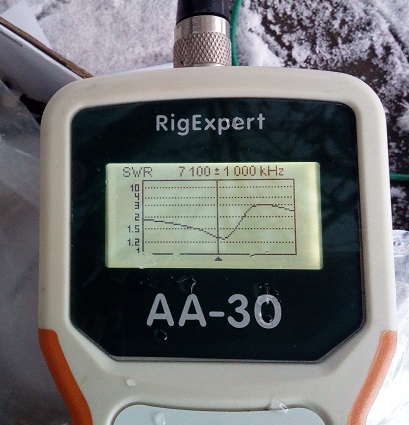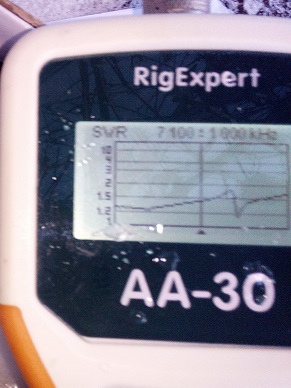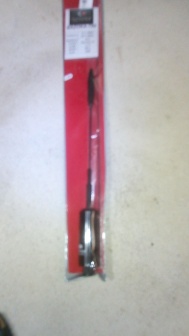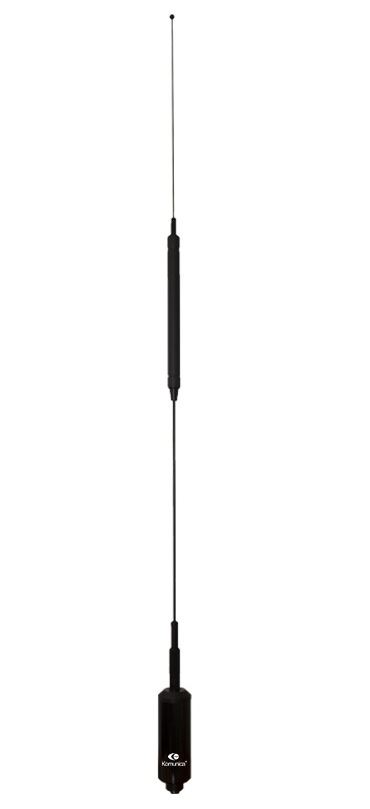 HF mobile antenna solution?
HF mobile antenna solution?
After spending time trying to make one of the patch-lead type commercial HF mobile antennas work on my car roof with a large three magnet base without success.
I had decided to buy two single band whips, one for 40m and one for 20m but when I saw this Spanish multi-band antenna at 99.95 Euros at Friedrichshafen, I decided to buy one, with the hope that it’s claim of being wide band from 7MHz to 30MHz with an SWR of 1.5:1 and not needing an ATU, would turn out to be true. The construction of the antenna looks VERY solid – similar to some 300 Euro models from other stalls at Friedrichshafen.
I found it rather nice that the CEO of the company approached me when I bought the antenna and asked me to send her feedback on what I found as this was a new product and they really need feedback for any future development if needed. It really is new – it’s not even on their website yet.
So how was my first test … rather good!
I attached my hefty three magnet base to the car roof and assembled the antenna – assembly is simply dropping the whip in the top and tightening the grub screw. I did have a little trouble here as the mount has been accurately machined so that I really had to push the whip in to get it far enough down for the grub screw to be able to clamp onto it. Once that was done, it was a matter of screwing the bottom of the antenna (PL259 plug) onto the base.
At the other end of the cable I attached my Rig Expert AA-30 Antenna analyser and scanned from 0-30MHz with an interesting result …. from 80 metres through to 10 metres the SWR is 1.2:1 – better than the advertised 1.5:1. Another interesting point – the SWR only goes up under 3MHz, so despite the antenna being sold as a 7-30MHz antenna, it looks like it should also work on 60 and 80 metres! Actually with an ATU, it’s supposed to work on 50MHz (6 metres) as well however as mobile or portable operation is not allowed on 6 metres in Germany, that capability is not relevant.
Next test
– drive out away from buildings, plug in the FT-817 and try the antenna out for real!
Unfortunately the results here were not so good. The signals I could hear were down on what I would expect and the stations called never responded to me.
I contacted the company and they said they had found a design/production fault and could I please await the new Bazoka Pro, due in September that would address the issues.
Update 13th. September – the new Bazoka Pro is shown onKomunica’s website and hopefully I will soon receive mine for evaluation and replacement of the Bazoka 780 (which will be sent back).
New “PRO” version arrived on Monday 18th. September, tested on Analyser 19th. September. Old Bazoka 680 model returned Wednesday 20th. September.
Analyser traces:
First “real” test of the new Bazoka Pro.
I went out to test my new mobile antenna out this morning, (21/09/2017) picked a spot away from buildings and the like and was interested with the results.
The PRO is the replacement antenna for the 680 and has been totally redesigned. It is still a wide band 7MHz – 30MHz loaded vertical from the company – Komunica Power in Spain.
What I found amazing was what I heard on 7MHz SSB just by tuning around. At 07:15 UTC on 7.138MHz there is a morning net between Europe and A/NZ. With this compromise wide-band antenna I could hear the following stations:
- G4AIR Dave in Cornwall (5-6),
- VK2SR Chris (5-3),
- G4UPE Dick in Kent(5-9),
- VK1TX Tex in Canberra(5-3),
- F5VBX Ann and F5VBY Tony in the South of France (5-9+),
- ZL1AIX Warren (5-2),
- G4NEY Jon in Cambridge (5-8).
Once the net closed when conditions closed-down at 07:45 UTC, I managed to work Tony F5VBY and Dick G4UPE with a report of 5-5 from Dick.
So I’m happy the antenna works, better than I expected. At the moment band conditions on bands other than 40 metres are horrible, so I can’t say how this antenna works on say 20 or 10 metres. But for now I am happy and have found that 40 metres opens to VK/ZL at the moment and perhaps will be possible from a summit at some point (once I get the time).
As the Bazoka PRO is documented as not requiring any ground plane I decided to try to use this antenna on a summit mounted on a small tripod. I already had a tripod with an SO-239 mount on it.
My tests took place on SOTA summit Attensberg DL/AL-276 on September 23rd. While the antenna on a tripod worked here VERY well on 40 metres (7MHz), 20 metres (14MHz) was a different situation. The band sounded very quiet. I know that conditions weren’t good but at the same time I suspected the antenna wasn’t working as well as it could.
For that reason, I planned another activation from an “easy” local summit Rentschen DL/AM-176, where I could put up both the Bazoka vertical and also my standard Inverted-V linked wire dipole. The results were very clear. Whereas the vertical was a little down on the dipole on 40m, considering difference in height, this was not a problem. 20 metres however was a black and white situation where the antenna simply could not hear stations that were relatively strong on the dipole.
The antenna analyser indicates a very flat coverage of frequencies from 10 to 30MHz. I decided I should try the antenna with an ATU – perhaps it was a matching problem or in fact, although the write-up says that no ground plane or counterpoise is needed, perhaps that’s only with regards to operation on 40m ?
The tests I carried out on Wednesday 11/10/2017, were simply with the antenna mounted on the tripod in my back garden.
First of all, I decided to compare absolute readings from the Antenna Analyser with the antenna on 40m and on 20m, these are the readings that I got:
40m: (7.1MHz) SWR 1.3:1 IZI=41.9 ohms R=41.2 ohms X=7.8 ohms L=175nH (no value for C)
20m: (14.285MHz) SWR 1.3:1 IZI=64 ohms R=63 ohms X=-4.8 ohms C=3400pF (no value for L)
My first change was to add a counterpoise (this is actually 3 radial wires cut for 20, 15 & 10m taped together into one wire which clips onto the outer of the PL259 socket on the tripod). The effect was immediate! OH8XAT was calling on 20m from Finland. Without the counterpoise on the antenna, he showed S1 on the FT817’s S-meter. Adding the counterpoise immediately brought him up to an indicated S8 signal. I repeated this test three times to make sure this wasn’t just conditions. The result stood.
Conclusion: When using the Bazoka not on a car roof, rather portable on a tripod, on bands other than 40m. A counterpoise IS needed.
Now what about an ATU – would that help further? The short answer is no. It did allow me to get the Antenna Analyser readings on 20 meters closer to those on 40m but made little difference to received signal strength. With the ATU in circuit the new readings for the Bazoka on the tripod on 20 metres were:
14.285MHz, SWR 1.23:1 IZI=60,7 ohms R=60 ohms X=3.8 ohms L=44nH (no reading of C).
I have yet to do a transmit test to see if the Counterpoise and the ATU help my transmitted signal strength. My suspicion is that the counterpoise is the main change needed with this antenna to use it portable, the ATU is less important.
January 2018 – new tests.
While I know the Bazoka Pro on a tripod works well on 40m and with an added counterpoise works better on 20m than without one, I was interested to read the manual of the Alpha Antennas wideband whip antenna. ( http://www.wimo.com/download/Tuner_Free_Directional_Alpha_Multiband_Antenna_Technical_Manual_v2.2.pdf ), which was linked to in a thraed on the SOTA reflector (http://reflector.sota.org.uk/t/advice-antenne-alpha-ez-military-vertical/16679).
Here’s that antennas operational description:
The Alpha Multiband Antenna is designed to simultaneously provide high-angle radiation (near vertical incidence – NVIS) and low-angle radiation (long-range and DX) propagation.
The targeted deployment variable includes the ability to launch your signal in the opposite direction the NVIS element is run away from the base of the antenna. Based upon how the tripod is tilted & NVIS element is deployed, this can provide directional propagation between 0 to 90 degrees above the horizon. While the NVIS element enhances short-range sky wave propagation, which varies from 0 to 300 miles, the Vertical element in tandem with the NVIS element enables long-range & DX propagation for distances greater than 300 miles.
This is an interesting approach, to use a wideband vertical with a random length, half of an Inverted-V antenna to get NVIS propagation as well as DX. So to fill in the “black-hole” normally caused by skip distance.
As the Bazoka Pro has two convenient holes on the top of it’s base “UnUn” unit (one of which has a screw at the bottom of it, so would only be usable with a very short screw), I can simply attach an “NVIS element” as described with the Alpha antenna and where I normally connect my counterpoise wires, instead attach an earth wire and the result will be similar to the Alpha Antenna.
My initial tests on the analyser produced the following comparison on 40 metres:
- with no NVIS wire:
 2. With NVIS lead added:
2. With NVIS lead added:  Of course an SWR trace is only part of the story – the real test will be when I get it out in the field (possibly on a summit next Monday). The weather at the moment is not conducive to extra tests!!It’ll be interesting to see whether the closer stations are stronger and workable with the “NVIS wire” on as opposed to without it. I’m not expecting much DX, but who knows …
Of course an SWR trace is only part of the story – the real test will be when I get it out in the field (possibly on a summit next Monday). The weather at the moment is not conducive to extra tests!!It’ll be interesting to see whether the closer stations are stronger and workable with the “NVIS wire” on as opposed to without it. I’m not expecting much DX, but who knows …
Short test 19/1/2018.
Before trying the updated antenna on a SOTA summit, I got the chance to shoot out to a local spot just outside the village where I had heard the VK stations using just the Komunica Bazoka Pro on the car roof back in 2017. Band conditions at the moment are no where near that good and the time was different but my short 30 minute test was so positive that I will try the wideband vertical + NVIS wire configuration from a SOTA summit soon.
What I found in this short test was a difference of 2-3 S-points on receive comparing the antenna on the (earthed) tripod, with and without the NVIS wire. It has to be said that the NVIS wire I created is a little heavy and a portion of it was laying on the ground. I have since created a new wire from much lighter wire so that hopefully I can keep it off the ground. It would be better also if the tripod was taller than it is – but it’s what I have.
Stations heard from: France, Germany, Spain and even a mobile in Finland! – all at S5-S9 signal strength. This was on a combination of 40m and 20m.
Station worked – using 30-35W (FT817 – homemade amplifier) – TM390SR (Special event station) – report given 5-9, received 5-7.
Whether the additional NVIS wire is actually creating a more NVIS type of signal of whether it just points out a problem with the broadband vertical, I don’t know, but what I do know is that it is a convenient set-up, which is easier to put up than my usual Inverted-V antenna on a squid pole.




You must be logged in to post a comment.